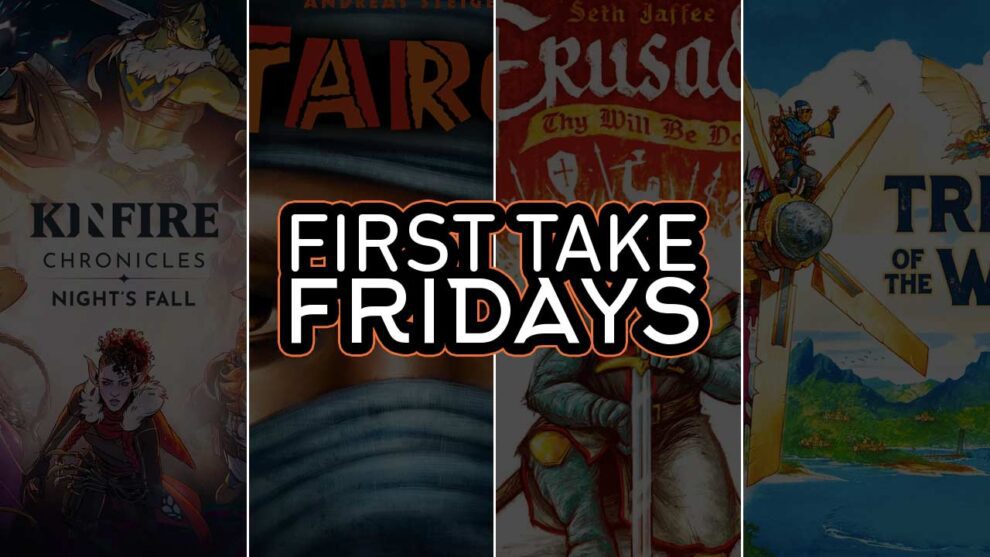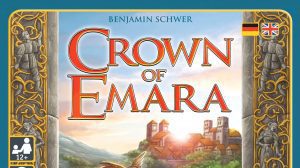Crusaders: Thy Will Be Done – Bob Pazehoski, Jr.
I’ve had my eye on Crusaders: Thy Will Be Done for a long time, so I was pretty excited to get it to the table. The game mechanism of a rondel governed by mancala-style movement is swift and responsive: take an action according to the number of tokens, then redistribute the tokens. The available action points are always in flux, creating tension between preparation and execution in the face of shifting opportunities.
There seem to be two ways to play Crusaders: with kindness and not. It’s easy enough to mind your business and chase your goals with minimal intrusion by others at the table. But it’s also easy to wait in the wings to snipe what another player has started, thwarting their hopes and dashing their dreams. The ideal is probably somewhere between. The colors pop, the components are exceedingly sturdy, the gameplay is quick, and the bit of engine-building can be quite satisfying. I won’t call it the most exciting game ever, but I would say it’s very good and definitely begs further play.
Ease of entry?:
★★★★☆ – The odd bump or two
Would I play it again?:
★★★★★ – Will definitely play it again
Watch our review of Crusaders: Thy Will Be Done.
Read more articles from Bob Pazehoski, Jr.
Targi – Tom Franklin
My friend and Meeple Mountain colleague David told me about Targi a while ago. Knowing I’m a fan of two-player strategy games, he thought I’d like it. Eventually, I picked up a copy…and let it sit on my game shelf for way too long.
Having now played Targi, I can say that I should listen to David more often. Targi is a simple mix of gathering resources and spending them to build up your end-of-game-scoring tableaux. Nine cards, a mix of resources and Tribes, are laid out in a 3×3 grid for all to see. You’ll place one of your three meeple on the cards that form a border to the central cards—cards that also provide you with one time benefits. Your meeple will intersect on two of the central cards and those are the cards you can claim.
You’ll exchange the first player token between players at the end of each turn, meaning you’ll get first crack at the board every other turn. This back and forth, along with some clever planning, will help you score points.
Ease of entry?:
★★★★★ – No sweat
Would I play it again?:
★★★★★ – Will definitely play it again
Read more articles from Tom Franklin.
Kinfire Chronicles: Night’s Fall – Jesse Fletcher
Kinfire Chronicles: Night’s Fall is a cooperative campaign game set in a magical fantasy world of Atios. Players take on the role of Seekers, sworn to protect the city of Din’Lux, and do some adventuring and exploring on the side. Kinfire plays 1-4 players; I opted to play Quest 1 solo. Quest 1 (The Road to Vinna) serves as a tutorial scenario, introducing you to only the combat system via a single boss battle. I presume that future scenarios will introduce the adventure and exploration elements. The gameplay is pretty straightforward. Actions are card-driven, but turn order is determined by drawing out chits from a bag. Additionally, players can play “boost” cards on other players’ turns to provide various forms of assistance. The tutorial scenario was difficult enough for me to feel a slight tension, but easy enough for me to emerge victorious by the use of timely cardplay. It was basically what you’d want for a tutorial: educational but mostly manageable, not too punishing for someone just learning the ropes. The scenario took about 30 minutes, and was interesting enough for me to want to try more.
Ease of entry?:
★★★★★ – No sweat
Would I play it again?:
★★★★★ – Will definitely play it again
Read more articles from Jesse Fletcher.
Tribes of the Wind – Justin Bell
There was a stretch of time—for about three weeks, after SPIEL 2022 wrapped up—when Tribes of the Wind was one of the hottest games in the world. Sold out at SPIEL. Beautiful artwork by Vincent Dutrait. An environmentally-friendly theme and messaging. Design work by Joachim Thome, who built one of my ten favorite games of 2021, Wild Space. It had everything going for it…until people just stopped talking about it.
I think I see now why the game hasn’t experienced continued love, despite steady ratings on BGG and from other outlets. The gameplay—featuring a mechanic that revolves around playing cards based on what you and your two immediate neighbors have in hand—doesn’t have many wow moments, but it does have a number of quiet, “hmm!” moments as a player realizes there is a card that is now available thanks to recent changes to a neighbor’s hand.
The teach is relatively straightforward, but the iconography required checks from the rulebook on almost every turn during our learning game. (The game badly needs a player aid.) There is a samey-ness (it’s a word, trust me) to each player’s board, where new villages have to be built in a post-apocalyptic land that must be cleared of pollution then settled by “Wind Riders” in your supply. Tribes of the Wind is a very heads-down game, in terms of direct interaction with the table. Players mostly stare at the backs of other players’ cards to see which ones they can play from hand.
Our first play, with five players, took about 90 minutes. That was too long for a game of this type, but that length wasn’t our main issue. None of us were particularly inclined to attack this a second time, and it made me realize that I really hadn’t heard anything new about this game in months. The world-building here is quite a sell, but there’s not much meat on the bone beyond a few mildly-interesting decisions sprinkled throughout play.
Ease of entry?:
★★★☆☆ – There were a few questions
Would I play it again?:
★★☆☆☆ – Would play again but would rather play something else













Add Comment